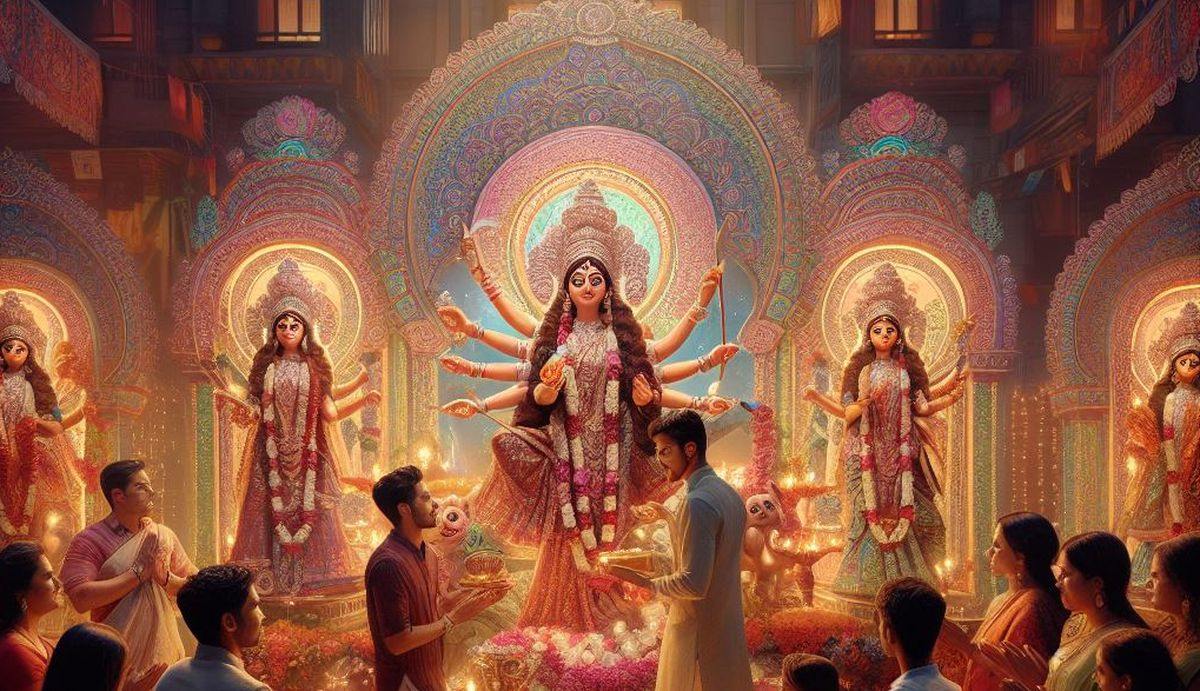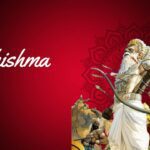No other festival in the world celebrates women’s power and victory like Durga Puja also known as Durgotsava or Sharodotsav. It is a festival of Hindus and is celebrated across the world by them.
Durga Puja will be celebrated between Fri, 20 Oct, 2023 – Tue, 24 Oct, 2023
During the Indian calendar month of Ashwin, which corresponds to September–October in the Gregorian calendar, on the first nine nights of the waxing new moon, Hindus across the world celebrate the autumn worship of the Great Goddess.
This Great Goddess is most often identified with Durga, an irresistibly beautiful female who rides a lion. Durgå represents the powers of all the gods and symbolically has all of their weapons.
She is regarded as the mother of all creation and the power that supports the entire universe. It is a nine-day autumn festival, celebrated throughout the subcontinent where communities gather with excitement for worship and celebration in well-decorated Puja celebration venues.
Festival activities begin months earlier, as communities organize themselves, collect money, purchase votive materials, and commission artisans and priests to prepare images and perform the rituals.
And then, over the course of those nine autumn nights, the preparations culminate in a remarkable blend of festivity, visual display, emotional catharsis, and high ritual in the votive rites to the Great Goddess.
Why is Durga Puja Celebrated?
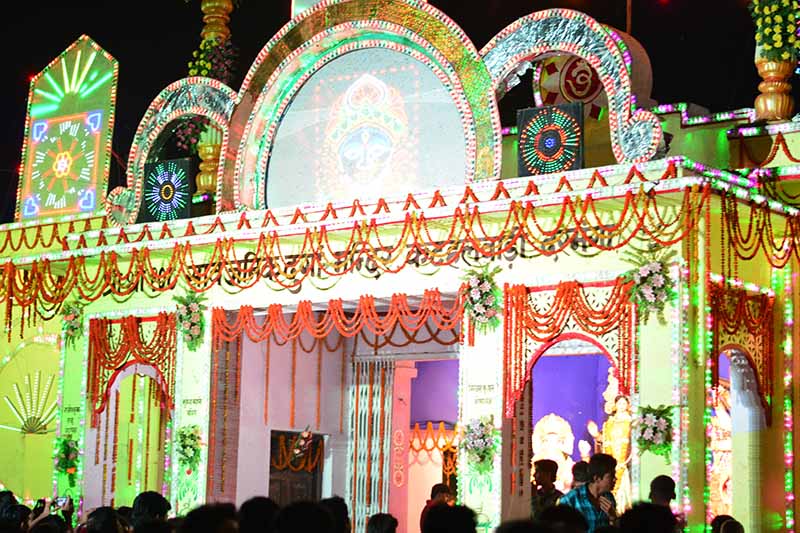
Durga Puja celebrates the Mother Goddess and female power (Shakti) in the Hindu tradition.
It is also a celebration of the victory of Goddess Durga over the evil buffalo demon Mahishasur. We need to look into the mythological background to know why Durga Puja is celebrated.
Background, The Story of Mahishasura
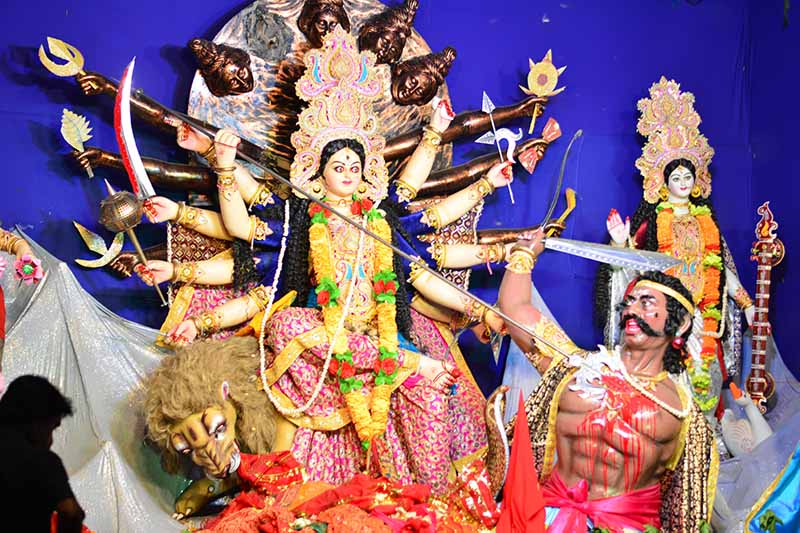
Once a demon king by the name of Mahishasura, performed severe austerities (Tapasya) and prayers going on for several years with a bad intention of seeking immortality from Lord Brahma.
Mahishasura Boon
Lord Brahma likes his devotion and gives him many boons. However, he asks for the boon of immortality. Brahma understanding that Mahishasura will misuse it, was reluctant to give the boon to him.
But Mahishasura was insistent that he deserved the boon of his choice or he didn’t need any boons. It was a moral dilemma for lord Bramha. Lord Bramha finally gives him the boon with the condition that he can only be killed by a woman.
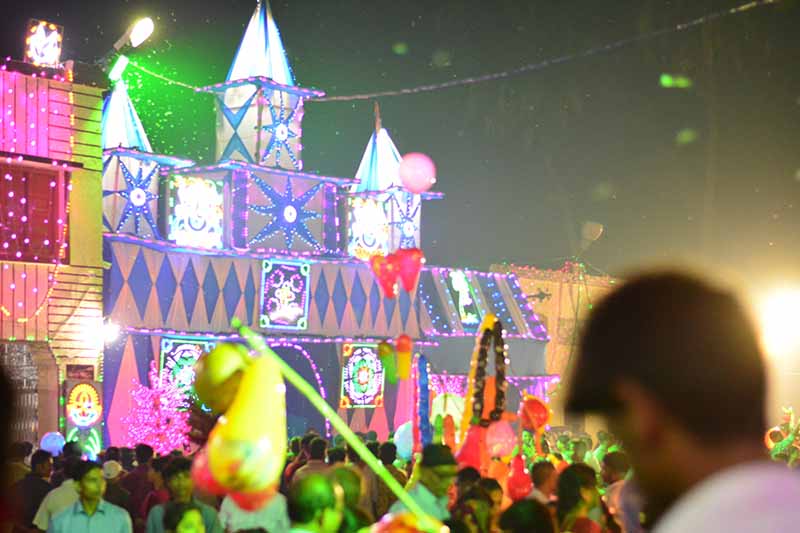
Durga Puja Festivity
On hearing the boon, Mahishasura was thrilled and considered himself immortal. He was thinking that a woman would ever match up to his strength and take his life. This boon for him was a sure way to immortality.
The Creation of Combined Divine Power
He considers himself immortal and wages a war against all the Devas, with his army of Asuras. In the battle, the Devas face defeat and so they approach the trinity of Shiva, Brahma, and Vishnu to seek help.
The three great gods combine their divine powers and create a woman and thus give rise to Goddess Durga, the embodiment of Shakti herself. Durga leads a battle against Mahishasura and kills him, thus fulfilling the prophecy that he would die at the hands of a woman.
Durga Puja in Indian Epic
There is the story of Lord Rama who first worshiped the ‘Mahishasura Mardini’ or the slayer of the buffalo-demon, by offering 108 blue lotuses and lighting 108 lamps, at this time of the year.
When is Durga Puja Celebrated?

Durga Puja is celebrated every year in the Hindu month of Ashwin (September-October) and celebrates Prince Rama’s invocation of the goddess before going to war with the demon king Ravana.
This autumnal ritual was different from the conventional Durga Puja, which is usually celebrated in the springtime. So, this Puja is also known as ‘akal-bodhan’ or out-of-season (‘akal’) worship (‘bodhan’).
How is Durga Puja Celebrated?
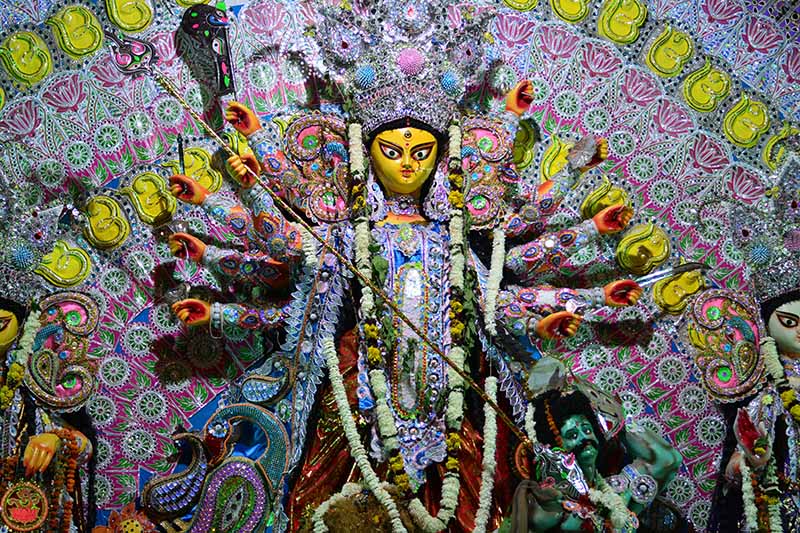
Durga Puja is celebrated very similar to Ganesh Chaturthi festival. It resembles the installation of tents and a huge statue and its immersion in the water.
The start of the festival sees large, beautifully decorated statues of Goddess Durga. They are installed in homes and podiums all over the city. At the end of the festival, the statues are marched through the streets, along with music and dancing, and then immersed in the water.
The festival begins with Mahalaya, a day where Shakta Hindus remember the loved ones who have died and the advent of Durga. It is also known as the Day of Kalash Staphan.
The next most significant day of Durga Puja celebrations is the sixth day, called Shashthi where the local community welcomes the goddess and festive celebrations are inaugurated.
On the seventh day (Saptami), eighth (Ashtami), and ninth (Navami), the goddess along with Lakshmi, Saraswati, Ganesha, and Kartikeya are revered and these days mark the main Puja (worship) with a recitation of the scriptures, the legends of Durga in Devi Mahatmya and social visits by families to elaborately decorated and lighted up temples and pandals (theatre like stages)
What Rituals are Performed During Durga Puja?
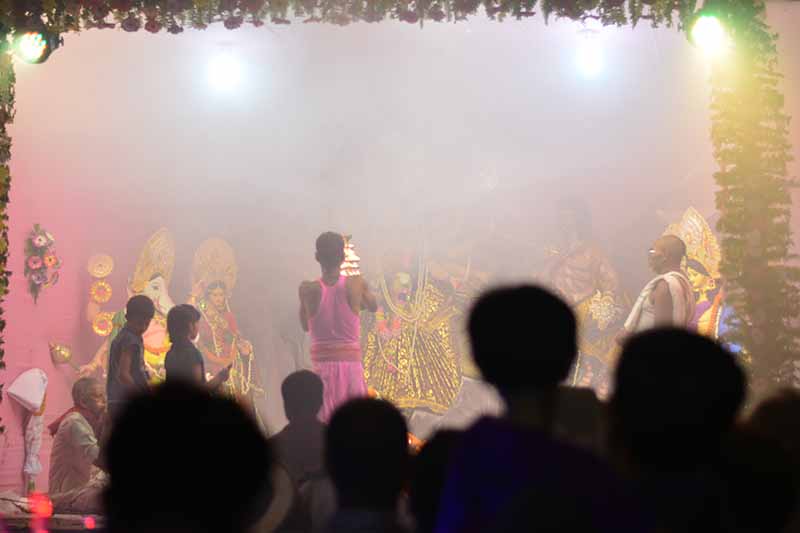
The Beginning
- Around one week before the festival starts, which is the occasion of Mahalaya. The Goddess is invited to come to the earth. Also, the eyes are drawn to the idols of the Goddess on this day, in an auspicious ritual called Chokkhu Daan. In 2018, this will take place on October 8.
- After the idols of Goddess Durga have been installed, a ritual is performed to invoke her holy presence into them on Saptami. This ritual is called Pran Pratisthan. It involves a small banana plant called a Kola Bou (banana bride), which is bathed in a nearby river, dressed in a sari, and used to transport the Goddess’s energy. In 2018, this will take place on October 16.
- Prayer offerings to the Goddess happen every day during the festival, and she is worshiped in various forms.
- On Ashtami, Goddess Durga’s worship starts in the form of a virgin girl in a ritual called the Kumari Puja. The word has its origin in Sanskrit Kaumarya, meaning “virgin”. The young girl’s worship happens as a manifestation of the divine female energy.
- The aim is to evolve the purity and divinity of women in society. It is a belief that the divinity of Goddess Durga descends into the girl after the Puja.
The End of Worship
- Worship concludes on Navami with a Maha aarti (great fire ceremony). It also marks the end of the important rituals and prayers. In 2018, this will take place on October 18.
- On the last day, Durga Mata returns to her husband’s abode and the statutes immersion process starts. Married women offer red vermillion powder(Sindoor) to the Goddess. And they smear themselves with it (this powder denotes the status of marriage, and hence fertility and bearing of children).
